Kicking ass and keeping things clean, that’s how we do things over here at AvalonKing. When it comes to consumer-grade ceramic coatings, Armor Shield IX continues to lead the pack in both customer satisfaction and protection performance, and its rise in popularity doesn’t seem to be slowing down any time soon.
But manufacturing and selling the highest rated DIY ceramic coating on the planet is just but one of the many jobs we take seriously over here at AvalonKing. Teaching our customers the importance of investing the time, money, energy, and resources in proper prep and application procedures is also vital.
For instance…
Proper aftercare is just as important as having the right products on hand, and the significance of practicing correct ceramic coating maintenance procedures should never be underestimated.
The following tips, tricks, and warnings are all considered vital ceramic coating maintenance must-know information, for proper care is what will guarantee that your vehicle achieves a 2-year AvalonKing longevity guarantee. Hell, with enough care, you might even be able to join the coveted “5-year ceramic coating club,” so pay heed to the following information.
How Strong is a Healthy Nano Ceramic Coating?
As the video above clearly illustrates, ceramic coatings serve a significant role in the automotive surface protection market. As the microscopic nano particles within these protectants penetrate the invisible imperfections spread across a hard surface and slowly begin to harden, they create a virtually impenetrable shield of armor that is stronger than the best clear coats on the market.
Clear coat, glass, carbon fiber, raw metal, chrome, unpainted plastic surfaces, fiberglass, truck nuts constructed from solid brass… if its hard and semi-porous, there’s a damn good chance ceramic coatings like Armor Shield IX can protect it.
A fully cured ceramic coating’s strength is graded upon what is commonly referred to as a pencil scratch hardness scale, or the “Wolff-Wilborn Test.” It is this scale that determines how well a ceramic coating can shield a surface against things like scratches and scuffs, and to this day remains a standardized test for all new ceramic coating products coming to market.
But contrary to common misconception, ceramic coatings are NOT tested on the Mohs scale, which is reserved for ranking the hardness of minerals and metals from 1–10. Instead, it’s the hardness of the graphite found in pencils that determines a ceramic coating’s resiliency.
For example, AvalonKing’s Armor Shield IX has earned a pencil scratch resistance rating of 9H, which is the highest achievable level a surface protectant can obtain after completing the “Wolff-Wilborn Test.” This equates to about a 6H rating on the Mohs mineral hardness test, which means that a pencil with a 9H graphite hardness rating will not scratch the protective surface.

Quick Nerd Note: You will occasionally see ceramic coating manufacturers claiming that they have developed a product with a 10H or 11H scratch resistance rating. This is complete bullshit. The pencil hardness scale only goes to 9H, and therefore the only thing going to 11 is that amp Spinal Tap just purchased.
7 Tips for Maintaining a Ceramic Coating
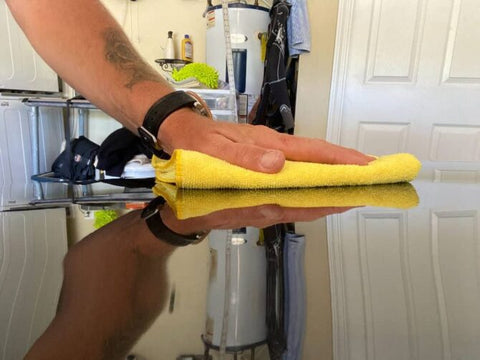
While a DIY nano ceramic coating creates a layer of surface protection that’s stronger than your garlic-loving aunt’s breath at the dinner table, it does still require some routine maintenance and care.
Adhering to the following five pillars of nano ceramic coating aftercare will not only help your vehicle’s exterior emerge as a winner in the long run, but it will make it look damn good in the process.
Tip #1: Wash Your Car Every Two Weeks

If you’ve ceramic coated your daily beater with Armor Shield IX, you should be adhering to a bi-weekly car wash routine. This will help remove any contamination that does not get kicked to the curb by the ceramic coating’s hydrophobic properties, and will keep things like water spots from forming.
Tip #2: Use the Two-Bucket Car Wash Method

The two-bucket method of washing a car is proven to reduce swirl marks and produce the best hand-wash results. For those of you who are not familiar with this technique, here’s a quick rundown on what this DIY “deluge of grandeur” entails.
By dunking your wash mitt in a bucket that’s been filled with water, you are able to decontaminate it prior to filling it up with the soapy suds floating in the second bucket sitting beside it. This rinsing dunk should be made every time your mitt begins to grow dirty or run low on car shampoo, as it will help prevent the harmful smearing of contaminants across the vehicle’s exterior.
Quick Tip: When you wash a vehicle with the two-bucket method, always work in a top-to-bottom approach, rinsing each section as you go. This will help prevent the spreading of heavier contaminants along the lower portions of the vehicle, and reduce the formation of water spots.
Tip #3: Use a Ceramic Coating Specific Car Shampoo

Just like there’s a reason why automotive-specific soaps exist, so too is there a reason behind the invention of ceramic coating specific car shampoos. Even many of the highly-rated car wash shampoos can contain abrasive chemical agents and punishing pH levels that will cause a silica-based ceramic coating to turn into a hot mess.
Always use a ceramic coating friendly car shampoo, as it will not only safely clean all those coated surfaces, but also add shine and rejuvenating properties to the coating.
Tip #4: Do Not Wash the Vehicle in Direct Sunlight

To ensure that your hard work returns optimum results, and prevent the formation of water spots, always scrub your vehicle beneath a covered structure, or in a heavily shaded outdoor area.
If neither of these is available to you, wash the vehicle in the early morning or during evening hours, when the sun is low in the horizon and shadows loom tall. Avoiding water spots at all cost, is the name of the game folks, and you have to play, regardless as to whether you want to or not.
Tip #5: Use Separate Car Wash Supplies for Wheels and Tires

Tires and wheels collect brake dust, road grime, deicing salt, and other forms of filth far faster than any other part on a vehicle, all due to their location. Brake dust in particular is super nasty stuff, as it consists of millions of microscopic shards of metal shavings and pulverized, sand-like substances.
Do yourself and your vehicle a favor. Wash your wheels and tires with a separate set of cleaning supplies first, as it will reduce the risk of spreading this nastiness to other areas of the vehicle.
Tip #6: Pay attention to environmental factors
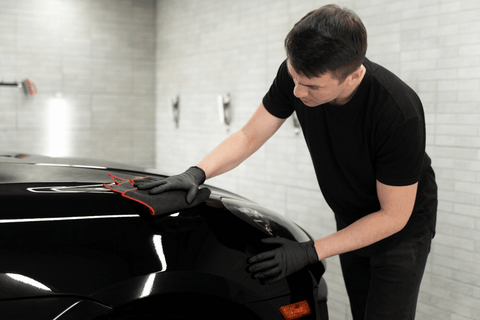
Ceramic coatings quickly degrade over time if they are overly exposed to environmental elements. Although they are mainly applied to protect your car’s paint, this does not mean you can leave it be and overuse it.
So, you must be mindful of these factors whenever you use your car or park it at home or outside. A few of the factors to look out for include:
- Intense Sunlight (UV rays)
- Harsh Winter Snow
- Heavy Rain
- Bird Droppings
- Tree Sap
- Road Salt
- Gravel and Debris
Tip #7: Do regular inspections and touch-ups

By now, you might already know that regular car washing is essential to maintaining your car’s ceramic coating. However, periodically inspecting for any signs of damage or wear can help you even more.
If you notice any issues, like water spotting, minor scratches, or contaminants, you should address them immediately. Doing this will help prevent minor issues from worsening over time.
Additionally, if you need to touch up your ceramic coating, don’t think twice and proceed to do it. It only takes about 5 minutes to quickly touch up your ceramic coating, especially with the use of Avalon King’s Armor Shield Lite.
What Should You Not Do After Ceramic Coating?
Like most DIY projects, there are also things you should avoid doing after finishing the coat application. Check them out below.
Dirt, Debris, and Other Damaging Natural Disasters

Now that we’ve established the fact that nano ceramic coatings are essentially quartz crystal infused clear coatings on steroids, it’s time to turn to the crap that they have to combat.
Like any worth adversary, Mother Nature has a slew of weapons at her disposal, including UV rays, dirt, sand, sea salt, tree sap, bug guts, bird shit, acid rain, and a million other invisible threats that are prone to slowly eating away at even the hardest ceramic coating.

So while a ceramic coating, like Armor Shield IX, will either repel or keep these naturally occurring contaminants safely stuck to its outer shell, they will eventually begin to take their toll if allowed to linger.
How to Remove Contaminants from Ceramic Coating
As your coating gets exposed to the sun and other microscopic contaminants over time, it could be embedded in the car's surface and negatively affect your coatings' appearance and performance.
So, removing contaminants from your vehicle’s ceramic coating will help ensure maximum performance and durability. But how exactly should you do it?
Here’s a quick rundown of how you can remove contaminants on your coated vehicle:
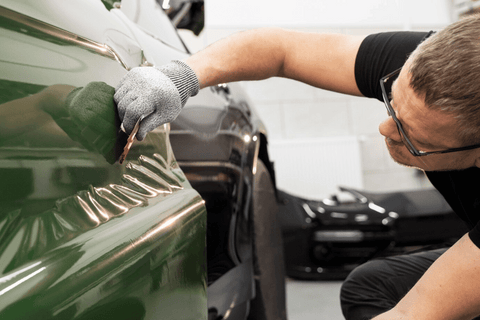
How to Wash a Ceramic Coated Car
A ceramic-coated car repels water and sheds dirt and debris quickly compared to vehicles that don’t have one. However, this does not mean it will not get dirty. The only difference is that washing a ceramic-coated car requires a more gentle approach.
Here are a few tips and tricks you can use when washing your ceramic-coated car:
- Only use the Two Bucket Method and avoid going to automatic car washes. This means you have one bucket of soapy water and the other for clean water.
- Use ceramic coat-friendly products such as Avalon King’s Ceramic Maintenance Shampoo, a soft wash mitt, microfiber towels for drying, and grit guards.
- Choose a shaded area when washing the car to avoid water spots.
- After drying, inspect the car for contaminants or any other issues. If needed, address these right away with the use of appropriate cleaning methods.
- Consider reapplying a thin layer of coating yearly after washing and decontamination.
How long after ceramic coating can I wash my car?
It is not suggested that your car get wet following the coating application to enable the coating to cure thoroughly first. So, the first wash after ceramic coating happens seven days after the application.
Some may say the waiting time will vary depending on the specific product and brand. When you use the Armor Shield IX DIY Ceramic Coating Kit, we suggest washing it a week after application to ensure the coating has fully set and improves its effectiveness.
What Happens if a Ceramic Coating Isn’t Well Maintained?
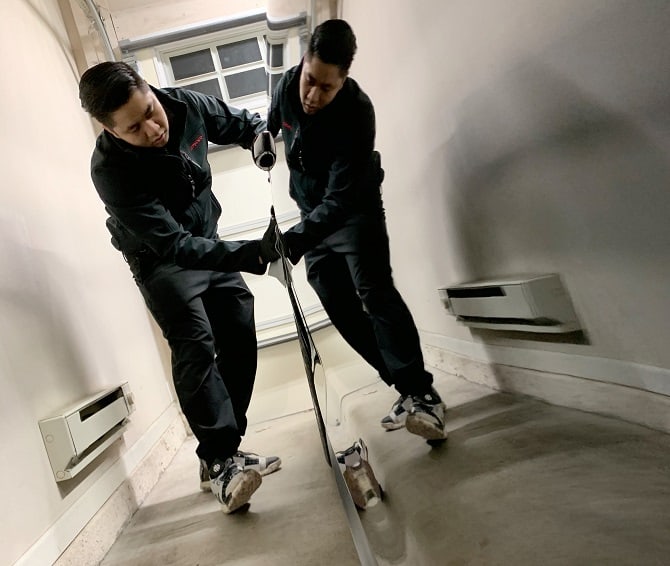
Contrary to the ceramic coating myths floating around on the internet, even the best SiO2-based products on the market today are far from bulletproof.
The old “set it and forget it” philosophy is only going to lead to massive issues down the line, and the following warning signs will be the first things you will notice when that nano ceramic coating starts to shit the bed.
Warning #1: Loss of Shine

One of the best features that a ceramic coating product like Armor Shield IX has to offer, is the brilliant shine it produces. However, if you neglect the coating, and filth begins to build, those hydrophobic repelling properties will begin to wane.
As your protective layer becomes increasingly frail, you will begin to notice that the shine and luster you’ve grown accustomed to are no longer present.
Rejuvenating ceramic coating boosting products may be able to help restore some of that shine, but if the coating is already a couple years old, chances are full failure is not far behind.
Warning #2: Reduced Hydrophobic Effects

AvalonKing customers love sending us pics and videos of how water, mud, dirt, and other contaminants literally slide off surfaces that have been coated with Armor Shield IX.
However, if those filthy machines remain unwashed and are allowed to soak-up excessive amounts of harmful UV rays, the hydrophobic repelling properties contained within the ceramic coating will begin to fail to function. The result? Standing water everywhere, along with every contaminant you wish to avoid.
Warning #3: Complete Failure
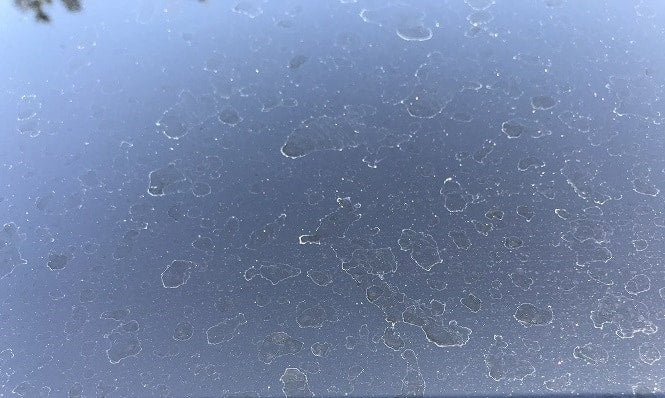
Eventually, all good things must come to an end, including that box of chocolates you’ve secretly been snacking on in your office desk. What? Didn’t think we would notice?
This same feeling of guilt is exactly what you will experience when your failure to maintain your vehicle’s ceramic coating literally causes it to fail. These products are marketed as a form of protection, NOT a permanent self-cleaning solution.
Ceramic coating failures may not be dangerous, but rarely are they very pretty. If you realize that your ceramic coating is beginning to lose its luster and is not performing like it once did, don’t hesitate to strip that coating away and begin to prepare the application process.
The Truth About Ceramic Coating SiO2 Boosters
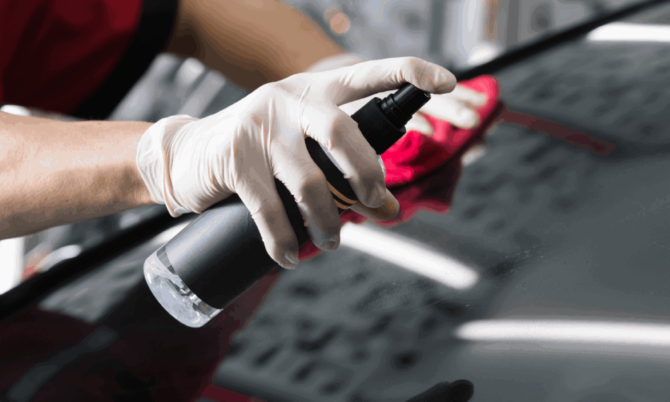
While we’re on the topic of maintaining ceramic coatings, we should probably discuss the whole SiO2 boost spray craze, and what it will and will not do for your coating of Armor Shield IX.
For starters, you should know that higher end boost sprays are indeed actually worth a damn, and they will indeed help rejuvenate the nano particles within a ceramic coating. While this elasticity will eventually begin to fail as well, the use of a quality SiO2 booster/topper will at least help slow down the degeneration.
The trick to selecting the right ceramic coating spray, is knowing that you need a product with around 20% silica (SiO2), and that routine applications yield the greatest results. Just be sure to thoroughly clean all ceramic coated surfaces with an approved automotive maintenance shampoo, and towel every square centimeter dry with an edgeless microfiber towel prior to application.
The last thing anyone wants is a bunch of grime hardening within their freshly applied booster spray, as mistakes such as these are sure to ruin anyone’s day. Oh look, it’s rhyme time once again…
Frequently Asked Questions (FAQs)
While maintaining a ceramic-coated car isn’t complicated, there are still a few frequently asked questions on how to do it – and we’re here to answer them for you.
Can I scratch my car even if it is ceramic-coated?
Ceramic coatings offer a protective layer for your car’s paint, but they are not 100% scratch-proof. It can only help resist light scratches, swirl marks, and minor imperfections. So, it’s essential to be mindful of hard or sharp objects, abrasive materials, and improper washing techniques, as they can still cause scratches.
How often should I apply ceramic coating?
When properly maintained, Avalon King’s Armor Shield IX DIY Ceramic Coating can last up to two years (or even more). Still, it is suggested that you touch up your ceramic coating and re-apply thin layers as maintenance boosters every six months. Doing this will help keep your coat in optimal condition.
Can you polish a ceramic coating?
Generally, it is not suggested that you polish ceramic coating. Polish has a restorative property, which means it would only strip away the layer of coat your car has. Using polish over ceramic coating is only recommended if you remove it and replace your vehicle with a new layer of ceramic coat.
Can you buff a ceramic coating?
Buffing ceramic coating is not recommended for the same reasons that polishing is discouraged. It involves mechanical action that can potentially remove the layer of coating, which you don’t want to happen when maintaining it. So, buffing the ceramic coating when removing it is only advisable.
How often should you ceramic coat a car?
The frequency of application of a ceramic coat to your car will depend on several factors. If you use Avalon King’s DIY ceramic coat, you can easily touch it up using the Ceramic Shield Lite every six months. Meanwhile, you can remove the coating thoroughly and re-apply another layer every two to three years to ensure optimal performance.
Can you pressure wash a ceramic-coated car?
Yes, pressure washing a ceramic-coated car is okay. Aside from automatic car washes and abrasive products, there are no other restrictions when washing your vehicle. Just follow the guidelines from your coat’s manufacturer, and only use specific maintenance soap and shampoos to avoid potential issues.
Can you use iron remover on ceramic coating?
Yes, you can use iron remover on the ceramic coating. It is suggested for decontaminating your ceramic coating and must be done every 1 to 2 years. Iron removers dissolve iron particles, dust, and other contaminants, so it will help keep your coat glossy throughout the years.
Parting Shots

Improving the life-expectancy and effectiveness of a ceramic coating is like oral hygiene. It may be a tad tedious and time consuming, but sticking with a routine that works will always bring forth the best results, and will keep you and you ride from looking haggard.
Fortunately, taking care of a nano ceramic coating is just as straightforward as maintaining your car’s clear coat. Wash it, dry it, and when it starts to look a little sad, add a splash of shine with a spray-on chemical solution.
Car owners who have been rocking Armor Shield IX on their rides for years all agree that having a ceramic coating in place does indeed make maintenance far easier. Yet this too is just but one gear in this ever-evolving surface protection and shine enhancing machine we’ve constructed, so be sure to peruse some of the other installments in the AvalonKing blog for even more useful information.





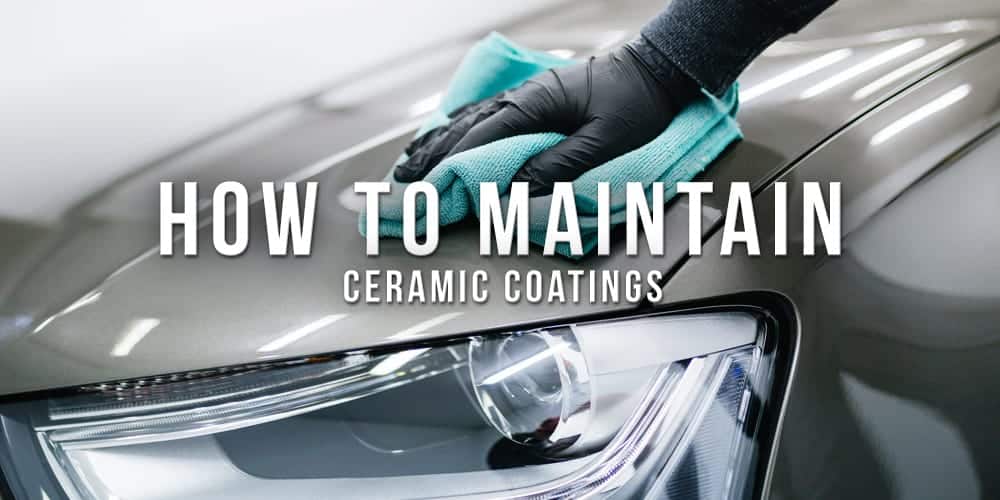




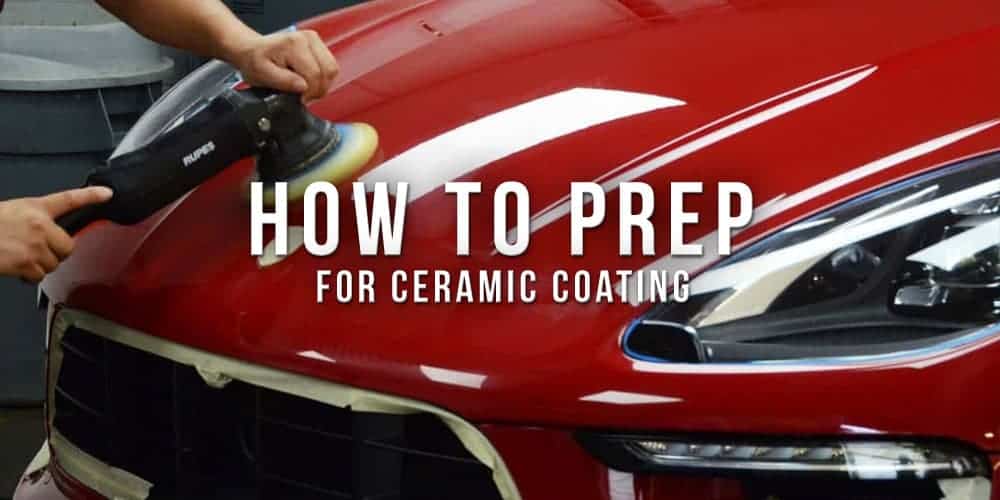
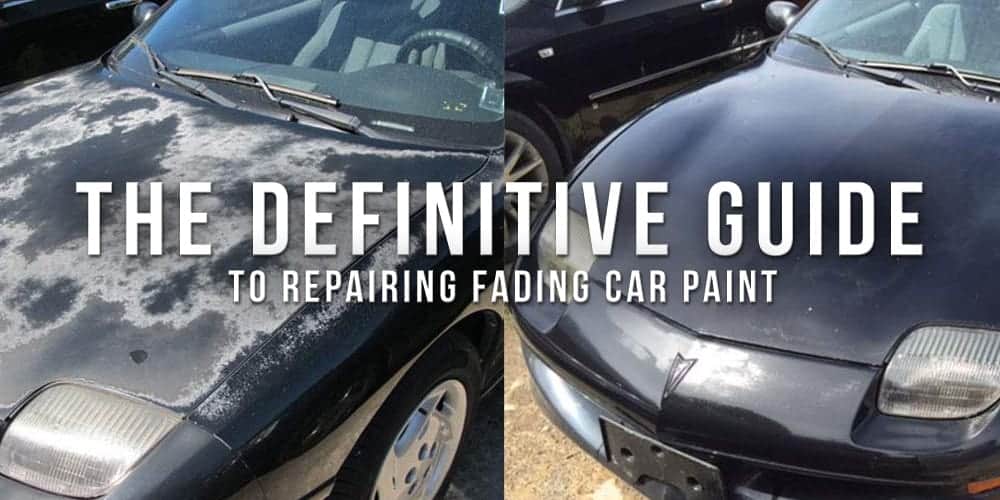

51 comments
Robert Simpson
I would be interested on advice on recoating the ceramic after a period of time. Obviously if it’s becoming dull or not repelling water it’s probably time. How long should this be? 1 year? 2 years? And should we add coatings at the first installation to prolong the time until recoating?
I would be interested on advice on recoating the ceramic after a period of time. Obviously if it’s becoming dull or not repelling water it’s probably time. How long should this be? 1 year? 2 years? And should we add coatings at the first installation to prolong the time until recoating?